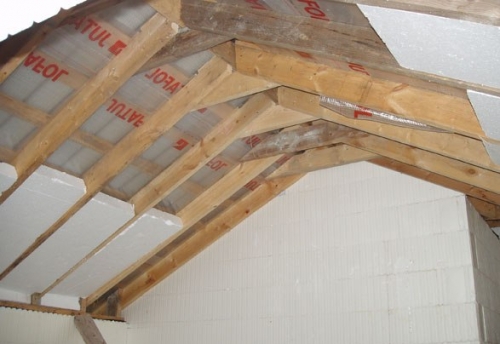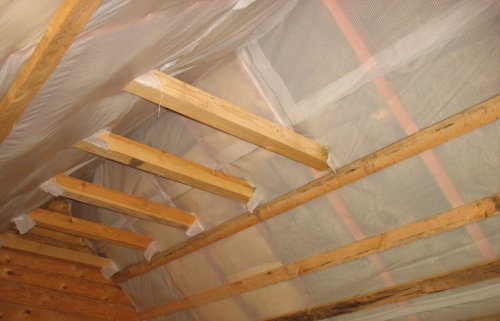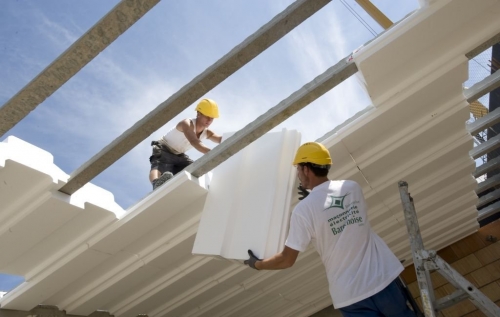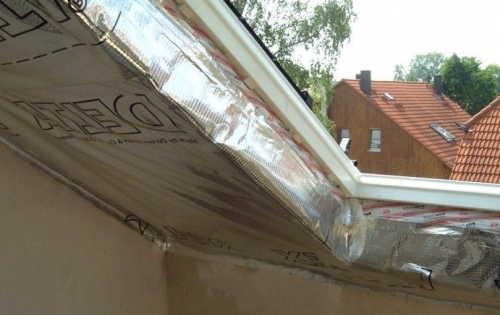The operation of the asbestos-cement slate reaches 50 years. However, with proper ...
|
|
Warming with foam of residential premises has gained popularity thanks to many ... |
Hidden wiring allows you to aesthetically place a network of wires along the area of \u200b\u200bthe room .... |
Roofing roof with foam with your own hands
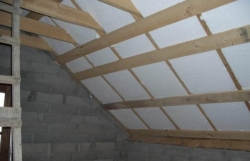
Any person understands well that the air rises up when heated. According to the laws of physics, the largest losses of heat in residential buildings will occur through the roof. Based on the huge number of advantages of using foam to warm the roof, we can safely say that this will be the best option for maintaining heat in your house, as well as fencing yourself from fungus and external noise. Therefore, we will tell in this article on how to organize roof insulation with foam.
Content:
The advantages of polystyrene as insulation
High -quality thermal insulation from the inside and outside allows you to protect the roof from external influences, such as temperature changes, which avoids the occurrence of cracks in the roofing material. It is recommended to warm the roof from the inside from the attic. The correct design of the roof pie includes a hydraulic tank, thermal insulation material, vapor barrier and interior decoration.
The role of insulation is often used foam. This is the light material of the white color, which consists of 98% of the air bubbles enclosed in a polystyrene membrane. Depending on the production method, the foam is conditionally divided into two categories: press and unreasonable. In front of other heat insulators, the foam has a lot of advantages:
- Light weight that facilitates the transportation of material and allows not to strengthen the supporting roof structures.
- Environmental safety proved by the fact that it is used in the food industry for the manufacture of packaging products and in the manufacture of children's toys. Foam is a non -toxic and non -nuclear compound: it has no smell, during processing it does not secrete dust and does not cause skin irritation and allergies.
- The small coefficient of thermal conductivity, since its composition has a lot of air, and the air is the best insulation.
- Good soundproofing abilities, therefore, with proper insulation of the roof, there is no need to carry out additional measures for wind protection with foam.
- The long period of useful operation, because the foam is not subject to aging and does not destroy over time, and its qualities do not deteriorate. The dimensions of foam plates remain stable throughout the entire period of use, do not decrease, do not sit down and do not move in the design.
- High moisture resistance, which is much lower than that of mineral wool, allows the use of polystyrene even in a humid environment, it does not lose its heat -insulating properties.
- Biological resistance. Foam on its surface does not form a nutrient medium for the growth and propagation of microorganisms and harmful bacteria, does not mold, does not rot, does not, unlike natural organic materials.
- Chemical device. Foam is chemically resistant does not respond to paints, adhesives, silicone, gypsum, cement, bitumen, lime and other chemicals and aggressive media.
- A high level of vapor permeability, so that the roof breathes and the excess moisture is evaporated, which has accumulated on the inside of the roof.
- Great resistance to temperature changes, as a result of which the foam does not change its structure, which allows you to use this material for warming the roof in different climatic conditions.
- Resistance to loads, long -term and short -term, significantly higher than that of mineral wool.
- Fire safety: Foam when contact with open fire is melted, but the flared does not occur, since its composition contains special additives, which give it firewood properties.
- Ease of use, because for working with polystyrene, expensive tools are not required, it is easily processed and cut by an ordinary knife.
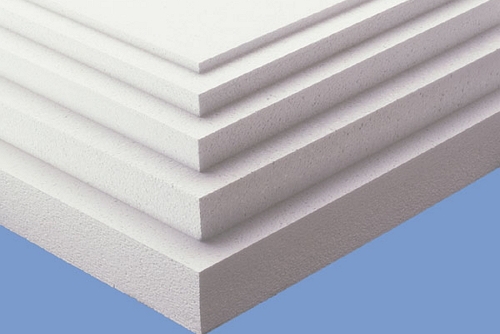
Roofing roof with foam with your own hands
The roof insulation with foam can be carried out in different versions of roof structures. Most often, this thermal insulation material is used on flat operated roofs. They can also insulate the pitched roofs, although experts have recently advised to choose mineral or glass wool for these purposes. Remember that polystyrene with the same layer thickness is more effective than any mineral wool.
Purchase of the material
To start the process of insulation of the roof from the inside and outside with a foam is a thorough choice and purchase of thermal insulation material. Before the insulation procedure, you should definitely ask if the attic overlap can withstand the estimated loads. Therefore, you need to adhere to the recommendations of the manufacturer that relate to the density of the foam.
PSB-S-15 foam, which has a density of 15 kg/m3 (PSB15) and a thickness of 50-100 millimeters, is characterized by high moisture resistance and low density. However, the material is pretty fragile and is used in places where high strength is not required. Such polystyrene is intended for ceilings, attic and pitched roofs.
PSB-S-25 foam with a density is close to 25 kg/m3 (PSB-25) and a thickness of 50 -100 millimeters is a universal thermal insulation material used to warm the floor, facade, internal walls and roofs. It is used for attic walls.

PSB-S-35 foam is characterized by high mechanical strength, it is ideal for styling in harsh climatic conditions. The material of the psb-S-50 brand is used outside for thermal insulation of surfaces, which are constantly subjected to mechanical influences. It is suitable for flat roofs, attic floors and floors, where significant loads are supposed.
In this case, it is necessary to calculate the insulation of the roof and the number of foam plates in order to cover the entire area of \u200b\u200bthe roof using this material. It is worth buying several plates in the stock. In order to reliably insulate the roof, except for the main component, you will also need a reliable waterproofing material, which serves as the basis for foam, gravel and geotextiles with which the insulation is covered.
After the acquisition of these materials, you need to deliver them to the place of work. When transporting, take into account that polystyrene is sensitive to external conditions, and it is recommended to transport it with great caution, avoiding mechanical shocks, exposure to direct sunlight and moisture. In this regard, it is advisable to order the delivery of foam to the house.
Roof preparation
The first step in the work is to check the rafters for various defects. It is necessary to see if they are exposed to rot or dampness. The beams that are rotten by the time of insulation of the guided roof should be replaced by installing new ones in their place, and treated with the help of fire chemical composition and antiseptic.
Also, if the roof is wooden, make sure that all the boards and beams are not damaged by insects, and so that there is no gap to form anywhere. If necessary, you can process the wood with special strengthening and disinfectant materials.
If the roof is flat and made of concrete blocks, then you need to inspect it for cracks, leaks and other defects. If they are available, then eliminate them by smearing cracks with a cement -sand mixture, and the places of leaks - waterproof.
Very often in houses, the attic space is equipped with a living room (attic). In most cases, such modernization is under construction with gable roofs. In this case, it is important to observe the minimum slope of the roof, this angle should be at least 25 degrees, which ensures free drainage of water from the roof to the gutter. If the angle is made more, the design of the roof can turn out unreliable.
Creation of vapor barrier
Before insulation of the roof, it must be vapor barred with foam. This procedure is needed to prevent the accumulation between the insulation material and the roof of condensate. If you use polystyrene from the inside without creating vapor barrier, then when the temperature changes from the inside and from the outside of the roof, moisture appears on the heater, which enters the pores of the insulation and freezes.
If wet polystyrene foam freezes, then the water will expand, destroying thermal insulation material. Therefore, according to the technology of roof insulation, the vapor barrier layer must be mandatory. As a vapor barrier, foil or film is usually used. When laying vapor barrier, you should pay attention so that the sides that do not pass moisture are facing the rafter structure.
Installation of foam plates
From a cold attic or attic, you can make a bright warm room in just a few days. If insulation is carried out during the construction of the roof, a crate should be filled with below on the rafters, which serves as a support for foam plates. When laying the material, it is necessary to observe the thickness of the roof insulation for a particular region.
When conducting such calculations, it is necessary to take into account, in addition to the climatic zone, and the used roofing material. But in any case, it is not recommended to lay material with a thickness of less than 100 millimeters. If one layer of polystyrene is small, and two layers exceed the size of the rafters in its height, in which case you will have to increase them, since the fastening of the sheets will be problematic.
The foam is laid between the rafters from the inside, observing a certain distance between the plates is 5 millimeters close, but not more than 10 millimeters. If you do not leave such intervals when warming the roof with foam, then the stoves during the shrinkage of a residential building will begin to push each other and as a result of this burst.
If the installation of polystyrene is not quite smooth and too large cracks formed between the plates of thermal insulation material, then they should be carefully seized. It is recommended to do the same operation in places where the details of the insulation are adjacent to roof structures. To fill the cracks most often use the mounting foam, which is applied by using a special gun that allows you to highlight all the mating and joints.
Attach foam slabs using wooden rails, mounting fungi or glue. The technique of gluing polystyrene plates to the surface is preferable. Less commonly used for these purposes, dowels or nails. However, over time, adhesive compounds lose their adhesive properties, therefore it is customary to combine the gluing of plates with their fixation on dowels or nails to increase the reliability of fastening of foam.
Often, attic overlap also needs thermal insulation. In this case, it is necessary to act in a similar way: to clean the ceiling from garbage and old backfill, lay vapor barrier. Foam sheets are laid out on the ceiling, then all the joints are disconnected. If you plan to turn the attic into a dwelling, then lay over the insulation a coating that can withstand the weight of people in the room, plumbing equipment and furniture parquet, board or laminate.
Laying waterproofing material
After you placed and fixed the foam slabs well, according to the roof laying scheme, they must be closed on top with waterproofing material. As waterproofing, you can use an ordinary roofing material or new materials made on the basis of foamed polyethylene. Waterproofing will protect the slabs from harmful effects.
One of the most effective waterproofing materials that are used when warming the roof with foam is geotextiles. Such a coating reliably covers sensitive foam and protects against various external threats, which include moisture, mechanical influences and ultraviolet radiation. Having put a geotextile layer on the foam, it must be attached to the back of the rafters using wooden rails.
At the same time, do not allow the tension of the waterproofing material, it is good if it sag slightly. Such a specific coating has its own characteristics, which lead to certain inconvenience when warming the roof with polystyrene. Since geotextiles are characterized by high density and does not pass moisture, there is always a risk of forming a certain amount of condensate on the inside of the fabric.
A similar phenomenon on polystyrene can not affect the best way, so you need to take preliminary measures to avoid this. The most effective method of avoiding the appearance of condensate is the pressure of geotextile material on a special crate, and not close to the layer of insulation. Such a crate provides the necessary ventilation of the undercarbon space between the coatings.
On top of such a roofing pie should make a concrete screed with concrete, which has a fraction of 16/32, or pour a layer of gravel, which has a thickness of 5 centimeters close. However, the thickness of this layer must first be calculated based on the wind strength in your region. Then you can proceed to the manufacture of a crate for laying a roofing.
When you finish the installation of a roof with a heater, from the inside of the roof you need to make a finish from the lining, drywall sheets or plastic panels. If you plan to equip a coating from putty, then you need to pre -glue the reinforcing mesh on the heat -insulating layer. Only such competent roof insulation with foam will become the key to creating a comfortable microclimate in the room!

